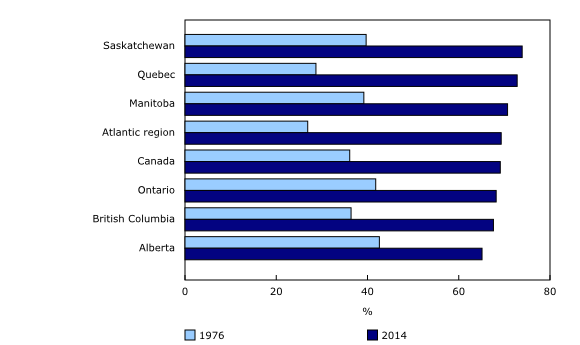Study: Employment patterns of families with children, 1976 to 2014
Archived Content
Information identified as archived is provided for reference, research or recordkeeping purposes. It is not subject to the Government of Canada Web Standards and has not been altered or updated since it was archived. Please "contact us" to request a format other than those available.
Released: 2015-06-24
In 2014, 69% of couple families with at least one child under 16 years of age had two working parents, up from 36% in 1976. This proportion increased in every province, but not equally among provinces.
There were 2.8 million couple families with at least one child under 16 in 2014—the same number as in 1976. However, the number of such families with two earning parents rose from 1.0 million in 1976 to 1.9 million in 2014.
Three-quarters of dual-earner families had two parents working on a full-time basis in 2014. This compared with two-thirds of dual-earner families in 1976.
The share of couple families who had one working parent—single-earner families—declined from 59% in 1976 to 27% of couple families with children in 2014.
The proportion of couple families with no working parents was 4% in 2014. This compared with less than 6% in 1976.
The number of families with a stay-at-home parent declines
Among single-earner families, some had a working parent, and a parent that was unemployed, going to school or permanently unable to work. Others had a working parent and a stay-at-home parent.
Between 1976 and 2014, the number of single-earner families with a stay-at-home parent declined from 1.5 million to 500,000. In other words, couple families with one stay-at-home parent represented less than one-fifth of couple families with children in 2014, down from more than half in 1976.
In 11% of cases, the stay-at-home parent was the father in 2014. This was the case with less than 2% of couple families with a stay-at-home parent in 1976.
Provincial differences in dual-earner families and families with a stay-at-home parent
Both the proportion of dual-earner families and families with a stay-at-home parent varied among provinces.
In 2014, Saskatchewan (74%) and Quebec (73%) had the highest proportions of dual-earning families among couple families with children. In 1976, the corresponding proportions were 40% for Saskatchewan and 29% for Quebec.
The lowest proportion of dual-earner families was in Alberta, with 65% in 2014. Alberta, however, had the highest proportion of dual-earner families in 1976 (with 43%), which suggests that the proportion of dual-earner families rose less rapidly in this province.
Alberta also had the highest proportion of couple families with a stay-at-home parent in 2014, as 26% of couple families with children in the province belonged to this category.
By contrast, Quebec (13%) had the lowest proportion of families with a stay-at-home parent in 2014. This was a significant change from 1976, when Quebec had the highest proportion of such families at 59%.
This suggests that the proportion of families with a stay-at-home parent declined faster in Quebec than in other regions of the country over the period.
Employment patterns of lone parents
There were almost 700,000 lone parents with at least one child under the age of 16 in 2014, accounting for 1 in 5 families with children. In 1976, there were less than 300,000 lone parents, accounting for approximately 1 in 10 families with children.
In 2014, 69% of lone mothers were employed, mostly on a full-time basis. This compared with a 75% rate among mothers in couple families, but represented a gain from the 48% of lone mothers who were employed in 1976.
Among lone fathers with children under 16 years old, 82% were employed in 2014, the same level as in 1976. This compared with 90% of fathers in couple families with children under 16 years old.
Note to readers
This study uses annual data from the Labour Force Survey (LFS). The LFS is a monthly survey that collects labour market information for all household members aged 15 and older as well as demographic and family relationship information for all household members, making it possible to derive family types. Excluded from the survey's coverage are persons living on reserves and other Aboriginal settlements, full-time members of the Canadian Forces, and the institutionalized population.
In this study, families are classified based on the type of economic family, and families with children are defined as those with at least one child under the age of 16. Couple families include married couples and common-law couples. Same-sex couples, however, cannot be identified with LFS data. Non-working parents who are unemployed, going to school, or permanently unable to work are not considered as stay-at-home parents. Also, parents on maternity or parental leave are not considered to be stay-at-home parents if they have a job to which they are returning.
In this study, work refers to paid work.
Products
The article "Employment patterns of families with children" is now available online in Insights on Canadian Society (75-006-X) from the Browse by key resource module of our website under Publications.
Contact information
For more information, contact us (toll-free 1-800-263-1136; 514-283-8300; infostats@statcan.gc.ca).
To enquire about the concepts, methods or data quality of this release, contact Sharanjit Uppal (613-854-3482; sharanjit.uppal@statcan.gc.ca), Labour Statistics Division.
For more information on Insights on Canadian Society, contact Sébastien LaRochelle-Côté (613-951-0803; sebastien.larochelle-cote@statcan.gc.ca), Labour Statistics Division.
- Date modified:


